
Botrytis cinerea is a necrotrophic fungus that affects many plant species, although its most notable hosts may be wine grapes. In viticulture, it is commonly known as "botrytis bunch rot"; in horticulture, it is usually called "grey mould" or "gray mold".

Salix fragilis, with the common names crack willow and brittle willow, is a species of willow native to Europe and Western Asia. It is native to riparian habitats, usually found growing beside rivers and streams, and in marshes and water meadow channels.
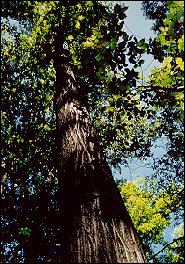
Juglans cinerea, commonly known as butternut or white walnut, is a species of walnut native to the eastern United States and southeast Canada.
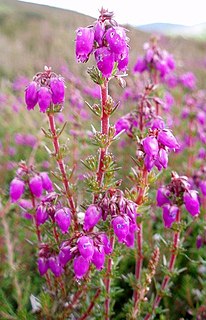
Erica cinerea is a species of flowering plant in the heath family Ericaceae, native to western and central Europe.

Salix cinerea is a species of willow native to Europe and western Asia.

Pomaderris is a genus of 70 species of shrub to small tree in the family Rhamnaceae. Sixty-five of the species are native to Australia and the other five are from New Zealand. There is some overlap. A distinctive feature of the leaves, branches, and twigs of this genus, is that they are hairy.
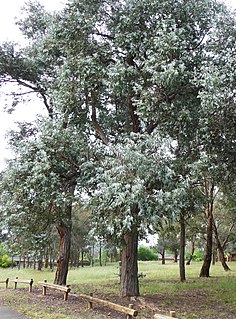
Eucalyptus cinerea, commonly known as the Argyle apple or mealy stringbark, is a species of small to medium-sized tree that is endemic to south-eastern Australia. It has rough, fibrous bark on the trunk and branches, usually only juvenile, glaucous, egg-shaped leaves, flower buds in groups of three, white flowers and conical to bell-shaped fruit.
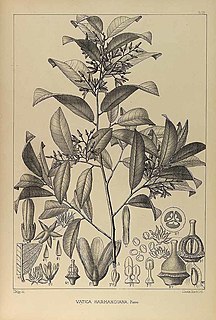
Vatica harmandiana, also known by the synonym Vatica cinerea, is a species of plant in the family Dipterocarpaceae. It is a smallish tree. It is usually not commercially harvested except for local use. It is the most common plant species in certain types of mature woodland habitat within its range and is furthermore common in disturbed secondary forests covering much of its range, nonetheless it was considered, along with most Dipterocarpaceae, to be endangered by the IUCN between 1998 and 2017.

Dichrostachys cinerea, known as sicklebush, Bell mimosa, Chinese lantern tree or Kalahari Christmas tree, is a legume of the genus Dichrostachys in the family Fabaceae.

Pomaderris aspera is a plant from eastern and southern Australia. Mostly seen south of the Barrington Tops in New South Wales to as far south as Wilsons Promontory and Cape Otway on the mainland. Also occurring in Tasmania. Scattered individuals are found in northern New South Wales to as far north as Bunya Mountains National Park in Queensland.

Pomaderris ferruginea is a species of shrubs and small trees from eastern and southern Australia. A common plant in forest, regularly along streams, particularly south of Stroud, New South Wales. A shrub up to 4 metres tall, it features rusty stems and hairs on the under side of the leaf. Though the upper surface of the leaf is hairless but not glossy. Leaves 6 to 10 cm long, lanceolate in shape. Cream or white flowers form in panicles at the end of branches, from September to October. The fruiting capsule and hypanthium have long silky hairs.
Pomaderris oraria, commonly known as Bassian pomaderris, is a shrub species native to the states of Victoria and Tasmania in Australia.

Pomaderris paniculosa, commonly known as scurfy pomaderris, is a shrub species native to southern Australia.

Pomaderris lanigera is a common plant from eastern and southern Australia. Often seen around 2 or 3 m tall, with furry leaves, 6 to 10 cm long, 1.5 to 3 cm wide. Leaf hairs appear woolly, of a silvery grey or rusty brown colour. Attractive golden flowers in August and September. The specific epithet lanigera comes from the Latin, meaning "woolly". The habitat varies, but it is often seen in moist gullies along the coast and nearby ranges.
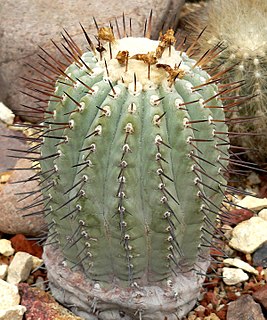
Copiapoa cinerea is a species of the genus Copiapoa in the family of Cactaceae. The epithet cinerea comes from the Latin word for ash, by reference to the colour of the epidermis.

Pomaderris apetala is a small tree or large shrub from the family Rhamnaceae, growing in Victoria, New Zealand and Tasmania. Two subspecies have been recognised:

Pomaderris vellea, commonly known as woolly pomaderris, is a shrub species that is native to the states of New South Wales and Queensland in Australia. It has an upright form and grows to 2 metres high. Panicles of small yellow flowers appear between September and October in the species native range.

Pomaderris vacciniifolia, the round-leaf pomaderris, is a spreading shrub, endemic to Victoria, Australia.

Mount Kaye is a mountain in the Coopracambra National Park, north of the township of Cann River in East Gippsland in Victoria, Australia.

Hakea cinerea, commonly known as ashy or grey hakea, is a shrub in the family Proteaceae native to areas along the south coast in the Goldfields-Esperance region of Western Australia. It is a showy ornamental species bearing creamy-white flowers aging to orange with contrasting ash coloured grey-green leaves.


















